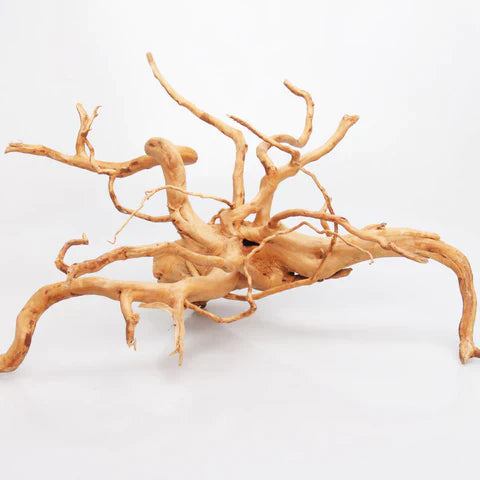
Aquarium Wood Options
This Blog discusses the best types of wood for aquariums. With so many types of wood now available its defiantly time to talk about them.
Can I use wood from my local river or lake?
Picking up wood from your local lake or river to place in your aquarium can have disastrous results in your aquarium and isn't worth the risk. Wood purchased from an aquarium shop would have been treated as well as pressure washed ensuring the risk of any issues is very small.
Wood in an aquarium can look stunning and offer lot of options for designing or scaping your aquarium. Some wood will release tannin into the aquarium so unless you're creating an Amazon biotope always ask how much tanning wood will release. Tanning isn't a bad thing in fact there are many benefits to tannin in your aquarium like lower Ph, fish colours look Vibrant. Tannin also creates a natural environment for the fish.
Option 1 - Driftwood
Aquarium driftwood is wood that has been washed up onto a beach, It's the remains of trees and tree roots and normally smooth. This driftwood provides a good shelter for species like pleco, catfish and shrimp. Driftwood can release some tanning into the water so if you don't want the tannin use Carbon or Purigen to remove it.
Option 2 - Mopani wood
Mopani wood is a very unique looking wood that can normally be found in a two-tone colour, dark brown and a cream colour it can be found in Africa this is probably why it's so thick and divers. Mopani wood has a very high tannin rate making it ideal for black water set ups. Mopani is normally chunky in shape however we do now sell mopani branches.

Option 3 - Spiderwood/Fingerwood
Spiderwood is well known for its varied branched appearance. This wood can be found in Mongolia and looks like a spider so hence the name "Spiderwood". Spiderwood is very lite in colour but once it's been in water for a few weeks it will go darker. This wood has a very low tannin rate so making it ideal for any aquarium. Spiderwood can float so we reccomend securing it down. At FishCove Aquatics we also offer packs of Spiderwood branches as detail for an aquascape. Why not add moss, java fern and anubias onto the wood to give it a different effect.

Option 4 - Corbo Wood
Corbo wood comes in many different shapes and sizes. The wood is hollow in the centre making it an ideal place to hide for species of pleco, catfish and dwarf cichlids. Corbo wood is mainly the stump of the tree, due to it being hollow its likely to float to ensure it is attached to something heavy. Once the corbo wood has taken on water it will sink. A small amount of tannin with come of this wood. Corbo wood has become one of the fastest selling woods we stock for aquascaping.

Option 5 - Ramous Wood
Ramous wood are the branches taken from the tree known as "Hawaiian hawthorn" Its dried and cured. Because of the many tiny sections that come of the main stem you can create a fantastic forest scape or create a bonsai effect by cutting and gluing sections together. If you're running Co2 maybe look at adding Ricca to it. Ramous wood is very light so will need to be attached so it doesn't float once you add water.

At FishCove Aquatics we try and have a large choice of wood for you to choose from, If you're not local we can arrange a video call so you can hand pick the wood and we can then send it on to you.
